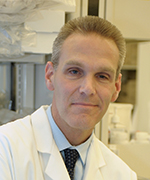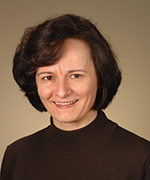Colleagues: Recently Tenured
ROBERT L. HANSON, M.D., M.P.H., NIDDK
Senior Investigator, Head, Genetic Epidemiology and Statistics Unit, Phoenix Epidemiology and Clinical Research Branch, National Institute of Diabetes and Digestive and Kidney Diseases

Education: University of Kansas, Lawrence, Kan. (B.A. in chemistry); University of Kansas School of Medicine, Kansas City, Kan. (M.D.); Columbia University School of Public Health, New York (M.P.H.)
Training: Residency in internal medicine, University Hospital, State University of New York (SUNY) at Stony Brook (Stony Brook, N.Y.); residency in Preventive Medicine and Public Health, SUNY–Stony Brook; U.S. Public Health Service Epidemiology Fellow, NIDDK (Phoenix, Ariz.)
Came to NIH: In 1991 for training; became staff scientist in 1998 and staff clinician in 2011
Selected professional activities: Member, American Diabetes Association Grant Review Committee
Website: https://irp.nih.gov/pi/robert-hanson
Research interests: The Phoenix Epidemiology and Clinical Research Branch conducts research on the causes and correlates of type 2 diabetes, obesity, and diabetic complications. My research has focused on the epidemiology of these disorders, particularly on the genetic and molecular aspects, in American Indian and other populations. We use classical techniques of epidemiology (descriptive, analytic, and experimental) as well as genetic epidemiology to study the genetic and nongenetic risk factors for diabetes, obesity, and complications of diabetes. We also study gene transcription, protein expression, and cellular metabolism. The branch is also investigating the effect of lifestyle interventions, such as promoting weight loss, in helping to prevent diabetes and its complications.
We have conducted several clinical trials to intervene in the natural history of diabetes and to prevent the development of the disease and its resulting severe complications. Although our genomic and molecular research does not have immediate clinical applications, it is helping us gain an understanding of the processes that lead to diabetes and related conditions. Ultimately, we hope that this knowledge will lead to better treatments and preventive strategies for these diseases.
The technology for studying the genetic and molecular aspects of diabetes is continuing to improve. The greatest challenge is to develop analytical methods that will allow scientists to interpret the results from these technical advances and to ensure that diverse populations are included in genomic and molecular research.
JAMES W. HODGE, PH.D., MBA, NCI-CCR
Senior Investigator; Head of the Recombinant Vaccine Group, Laboratory of Tumor Immunology and Biology, Center for Cancer Research, National Cancer Institute

Education: University of Tennessee, Martin, Tenn. (B.S. in biology and chemistry); University of Tennessee, Knoxville, Tenn. (M.S. in microbiology; Ph.D. in comparative and experimental medicine); George Washington University, Washington, D.C. (M.B.A. in medicine and health care)
Training: Intramural Research Training Award postdoctoral fellow, NCI
Came to NIH: In 1993 for training; held positions of senior staff fellow, staff scientist, and senior scientist (1996–2011); became investigator in 2011
Selected professional activities: Chairman, Immunomodulation Committee, NRG Oncology; senior visiting professor (adjunct), Department of Radiation Oncology and Surgery, Albert Einstein College of Medicine (New York)
Outside interests: Running marathons and triathlons
Website: https://irp.nih.gov/pi/james-hodge
Research interests: My group is developing novel recombinant vaccines and vaccine-combinatorial therapies. We study both mechanistically and operationally how certain radiation modalities, chemotherapy agents, small-molecule targeted therapies, and immune modulators alter tumors or their microenvironments to make them more sensitive to immunostimulatory vaccines.
Immune consequences of cancer therapy include both direct effects on tumor cells and modulation of the immune system. My laboratory has focused on two areas: immunogenic modulation and immune subset conditioning.
Immunogenic modulation describes the mechanism of how anticancer therapies alter the biology of the surviving tumor cells to render them more sensitive to immune-mediated killing. Immunogenic modulation encompasses a spectrum of molecular alterations in the biology of the cancer cell that independently or collectively make the tumor more amenable to cytotoxic T-lymphocyte–mediated destruction.
Immune subset conditioning describes how anticancer therapies mediate the peripheral and/or intratumoral reduction of negative regulatory elements into a more immune-permissive environment for vaccine immunotherapy. Understanding the underlying mechanisms of these areas provides a rationale for the use of immunotherapy in combination with radiation, chemotherapy, small-molecule inhibitors, and immune modulators.
Our team has worked independently and collaboratively with the Laboratory of Tumor Immunology and Biology on the design, engineering, and development of recombinant poxvirus and yeast-based cancer vaccine platforms. The poxviral vector–based vaccines contain transgenes for tumor antigens and for multiple synergistic costimulatory molecules. These vaccines based on three costimulatory molecules (TRICOM) have led to several clinical trials showing improved patient survival for a range of human carcinomas. The prostate-specific antigen (PSA)–TRICOM vaccine, designed to generate a robust immune response against PSA-expressing tumor cells, is in a phase 3 clinical trial for metastatic prostate cancer.
CHARLES MATTHEWS, PH.D., NCI-DCEG
Senior Investigator, Metabolic Epidemiology Branch, Division of Cancer Epidemiology and Genetics, National Cancer Institute

Education: University of Massachusetts Amherst, Amherst, Mass. (B.S. in exercise science); University of South Carolina, Columbia, S.C. (M.S. in exercise science); University of Massachusetts, Amherst (Ph.D. in epidemiology)
Training: Postdoctoral fellow, Division of Preventive and Behavioral Medicine, University of Massachusetts Medical School (Worcester, Mass.)
Before coming to NIH: Assistant professor of medicine, Vanderbilt University School of Medicine (Nashville, Tenn.)
Came to NIH: In 2009
Selected professional activities: Associate editor, Medicine and Science in Sports and Exercise, American College of Sports Medicine’s flagship journal; epidemiology and biostatistics representative on Program Committee for the 2016 American College of Sports Medicine Annual Meeting
Outside interests: Enjoying the family meal; riding bikes; playing with dogs; watching baseball; listening to music; digging for vinyl LPs
Website: https://irp.nih.gov/pi/charles-matthews
Research interests: I study the relationship between physical-activity behaviors and the development of cancer. These behaviors range from the purely sedentary to high-intensity physical activity such as running; they reflect the continuum of human movement that we engage in each day. An individual’s overall profile of physical behavior has an important influence on the amount of energy he or she expends each day and the underlying metabolism. In my etiologic studies, I seek to understand how the full spectrum of physical behavior influences cancer risks, the dose-response relationships between active and sedentary behaviors and cancer, and the biological mechanisms underlying these relationships.
Research has shown that moderate- to vigorous-intensity exercise is associated with reduced risk of many cancers with the most evidence available for colon cancer, postmenopausal breast cancer, and endometrial cancers. But we don’t know precisely how much exercise is required to reduce the risk for these malignancies or what the metabolic mediators are. I am currently conducting studies to better understand the minimal amount of exercise needed to provide benefit, the effect of aerobic exercise on circulating hormones, and other metabolic factors that could explain the observed associations. I am also exploring whether excessive sedentary behavior (“too much sitting”) may be linked to an increased risk for certain cancers independent of the effect of exercise. My long-term goal is to understand the optimal ratio of sedentary time (which is a necessity for many in modern life) to physically active time for lower cancer risk and better health.
To help achieve this goal I engage in methodological research to develop better tools to measure the full spectrum of physical-activity behaviors in large population-based studies. We have learned a great deal about the important role that exercise can play in cancer prevention using simplistic questionnaires, but it may be that our traditional questionnaire-based approach limits our ability to rigorously test new hypotheses about sedentary behavior and the potential benefits from routine activities of everyday living. We are now testing and refining next-generation measurement methods that rely on mobile technologies and accelerometers to capture a more complete, accurate, and precise measure of human behavior. I hope that by implementing these tools in future studies, we will accelerate discoveries that could lead to fundamentally new strategies for cancer prevention through increased physical activity.
STEFAN A. MULJO, PH.D., NIAID
Senior Investigator, Chief, Integrative Immunobiology Section, Laboratory of Immunology, National Institute of Allergy and Infectious Diseases

Education: Johns Hopkins University, Baltimore (B.A. in biology honors program; M.H.S. in molecular microbiology and immunology; Ph.D. in molecular biology and genetics)
Training: Visiting postdoctoral researcher, Department of Molecular and Cell Biology, University of California, Berkeley (Berkeley, Calif.); postdoctoral research fellow, Department of Pathology, Harvard Medical School (Boston)
Came to NIH: In 2008
Selected professional activities: Advisory board member (Immunology section) of Oncotarget; faculty member of NIH-Penn Immunology Graduate Partnership Program
Outside interests: Cooking; eating; traveling; talking about science with his wife (also a scientist); keeping their kids entertained and out of trouble
Website: https://irp.nih.gov/pi/stefan-muljo
Research interests: The Integrative Immunobiology Section is interested in understanding how gene-expression programs are orchestrated as cells differentiate from stem cells into various lineages in the immune system. In particular, my lab studies how these systems are controlled by microRNAs, long noncoding RNAs, and RNA-binding proteins. Our major goal is to discover novel molecular circuits that control cell fates in the hematopoietic and immune systems because perturbations in their genetic programming underlie many diseases and disorders including cancer, immunodeficiency, autoimmunity, inflammation, allergy, and infectious diseases.
To address these fundamental issues, we use an integrative systems-biology approach to reverse engineer the molecular logic of cellular differentiation. We combine genome- and transcriptome-wide measurements with experimental perturbations in order to test and refine our models.
As one example of our success, we identified the RNA-binding protein LIN-28 homolog B (LIN-28B), which causes hematopoietic stem cells (HSCs) from bone marrow of adults to acquire some of the attributes of fetal HSCs. We helped show that human LIN-28B can activate a program that includes fetal hemoglobin expression during erythroid differentiation, providing a novel avenue toward the treatment of beta-thalassemia and sickle-cell disease, inherited conditions that affect hemoglobin and arise from mutations in adult beta-globin. Furthermore, using LIN-28B–reprogrammed adult HSCs in a transplant, particularly in pediatric patients or someday in utero, offers the potential for the blood and immune systems to develop anew, similar to how the immune system develops in a fetus or a newborn. Converting adult human HSCs into more fetal-like cells with LIN-28B also offers an easy and ethical way to further study fetal HSCs in the laboratory.
MIHAELA SERPE, PH.D., NICHD
Senior Investigator; Head of the Section on Cellular Communication, Eunice Kennedy Shriver National Institute of Child Health and Human Development

Education: University of Bucharest, Bucharest, Romania (M.S. in biochemistry); State University of New York at Buffalo, Buffalo, N.Y. (Ph.D. in biochemistry)
Training: Postdoctoral training in developmental biology and neurobiology, University of Minnesota and Howard Hughes Medical Institute (Minneapolis)
Came to NIH: In 2008
Selected professional activities: Organizer of the Genetics Society of America Drosophila meeting (2014)
Outside interests: Listening to all kinds of music (from jazz to classical); hiking; baking
Website: https://irp.nih.gov/pi/mihaela-serpe
Research interests: The purpose of my lab’s research is to understand the mechanisms of synapse development and homeostasis. We focus on three key processes in synaptogenesis: 1) trafficking of components to the proper site, 2) organizing those components to build synaptic structures, and 3) the maturation and homeostasis of the synapse to optimize its activity. My laboratory addresses the underlying mechanisms using a powerful genetic system, Drosophila melanogaster, and a comprehensive set of approaches including genetics, biochemistry, molecular biology, super-resolution imaging, and electrophysiology recordings in live animals and reconstituted systems. We use the neuromuscular junction (NMJ) as a model for glutamatergic synapse development and function. Individual NMJs are uniquely suited for in vivo studies on synapse assembly, growth, and plasticity, because they can be reproducibly identified from animal to animal and are easily accessible for electrophysiological and optical analysis.
Although many neurological disorders are linked to defects in synaptogenesis, the initial clustering functions are poorly understood. We discovered an obligatory auxiliary protein, neuropilin and tolloid-like (Neto), which is absolutely required for the ionotropic glutamate receptors (iGluRs) clustering and NMJ functionality.
Neto belongs to a family of highly conserved auxiliary proteins that regulate glutamatergic synapses, the major excitatory synapses in the human brain. Our investigations uncovered essential roles for Neto during synapse development and support the notion that Neto tightly regulates the trafficking of iGluRs on the muscle membrane, their synaptic recruitment and stabilization, and their function. Furthermore, Neto appears to be at the center of trans-synaptic complexes that monitor synapse activity and relays this information to the presynaptic bone morphogenetic protein (BMP) signaling pathway.
We have recently discovered a completely novel BMP-signaling modality that is genetically distinguishable from any other known BMP pathways. At the NMJ, this novel BMP pathway is triggered by selective postsynaptic iGluRs and acts locally to promote the stabilization of these receptors at synaptic sites. Thus, BMPs may monitor synapse activity and coordinate it with synapse growth and maturation. We are currently trying to elucidate the molecular components, regulation, and function of this novel BMP-signaling modality, which appears to have a broad, ancestral role in regulating cellular junctions.
This page was last updated on Wednesday, April 13, 2022
